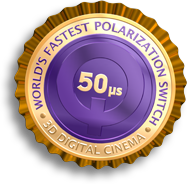
Answers to Frequently Asked Questions
Important DepthQ 3D Technical Questions
Q: What is DepthQ 3D?
A: When combined with a silver screen, DepthQ 3D allows your digital cinema projector to display stunning stereoscopic 3D films, viewable using inexpensive industry-standard passive glasses.
DepthQ 3D products for 3D digital cinema consist of our patented DepthQ Standard Polarization Modulator and our newly patented high-brightness DepthQ CineBrightTM 3D Light Recycler.
Both products enable the world's shortest dark times - thus easily ensuring bright, low-crosstalk operation. Please read on to discover what other benefits help to qualifiy them as "Best in Class".
 DepthQ 3D products allow your digital cinema projector to display stunning stereoscopic 3D films,
DepthQ 3D products allow your digital cinema projector to display stunning stereoscopic 3D films,
viewable using inexpensive industry-standard passive glasses. DepthQ Standard pictured.
Q: What factors determine the best 3D experience for my patrons?
A: With liquid crystal based polarization modulators, the quality of the optics is most important, and determined by several factors: optical efficiency, switching speed, flatness/focus, contrast and heat protection. DepthQ 3D's optics are superior to our competitors in these areas.
Other factors include your projector's dark time, lamp life, the quality of your port glass, the glasses you choose and your screen. Read on to see how ALL of these factors affect your Total System Efficiency (how much light your patrons ultimately see)
Q: What is the Optical Effciency of the DepthQ 3D products?
A: All LC-based polarization switches start with nearly identical per-eye Optical Efficiencies of ~17% (including the 3D glasses).
DepthQ Standard
is actually ~17.5% optically efficient (i.e. light-efficient) using common low-cost cinema glasses, or up to ~19% with premium (expensive) glasses.
DepthQ CineBright
because it recaptures and re-uses some of that lost light, is ~28% optically efficient using common low-cost cinema glasses, or up to ~31% with premium (expensive) glasses.
However, it's important to note that Optical Efficiency is not the only efficiency that matters, as there are further reductions in brightness before light actually reaches your guests, including losses from 'Dark Time', color correction, and projection port glass. Of these, a 3D product's required Dark Time is really the most important factor, as this dramatically effects Total System Efficiency (how much light your patrons ultimately see).
Q: Can every product benefit from 'premium glasses'?
A: Yes, 'premium glasses' using higher-quality components can increase everyone's Optical Efficiency, but at 'premium prices' prohibitive to running a theater. Know that any marketed brightness values based solely on using premium glasses are not realistic for 3D cinema.
Also note: some inexpensive 3D glasses measure out to appear more efficient than others, but receive their increase in brightness by leaking more crosstalk (ghosting) through them, providing a poor customer experience.
Q: What is DepthQ 3D's Switching Time?
A: DepthQ 3D has a patented, symmetrical Switching Time of only 50 microseconds (µsec), while our competitors' products simply cannot completely switch faster than ~550µsec in each direction - and some are considerably slower than that.
Current digital cinema projector technology does not yet take advantage of our extreme switching speed. The fastest they switch today is approximately 350µsec. But at 50µsec DepthQ easily and completely switches states within this 350µsec. Competing products simply cannot.
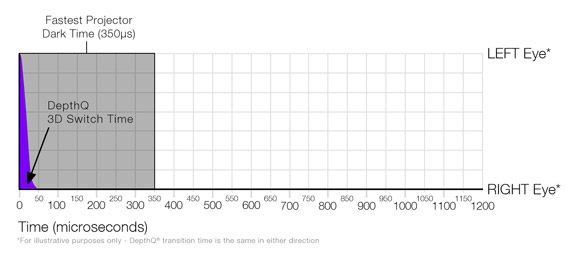 DepthQ 3D is DONE switching well within the fastest projector Dark Time of 350µsec.
DepthQ 3D is DONE switching well within the fastest projector Dark Time of 350µsec.
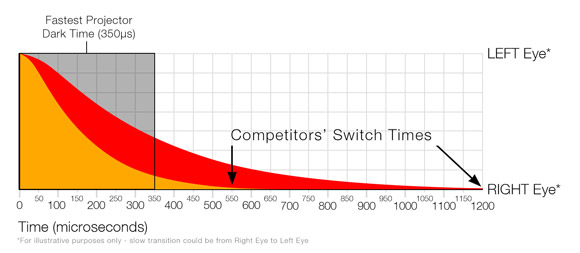 Our competitors take up to 24 times as long to switch eyes.
Our competitors take up to 24 times as long to switch eyes.
Q: What is Dark Time?
A: 'Dark Time' is the time projector light must be turned OFF between Left and Right images to allow a 3D product to switch eyes. The longer the Dark Time, the less light to the screen.
At 50µsec, DepthQ 3D switches far faster than the fastest projector Dark Time available to date of 350µsec, producing the highest Total System Efficiency in our class. A competitor's manual states their modulator requires a Dark Time of 1200µsec while a spinning wheel polarizer requires 1157µsec (for triple-flashed 24FPS content).
Hit 'Play' to see the difference using split screen. On the left is a test pattern projected using DepthQ 3D's minimum projector Dark Time of 350µs. Watch the noticeable brightness change as Dark Time is increased using the same test pattern on the right (Note - no modulators were used, this is just the effect of Dark Time on projection brightness):
Split-screen reveals visible dimming in the right half of the white circle as Dark Time is increased.
Q: How do Switching Time, Dark Time and Crosstalk relate?
A: If a 3D product does not finish switching within the projector's Dark Time, one eye will see light meant for the other eye. This is called 'Crosstalk' (ghosting). Setting a projector's Dark Time faster than a product's Switching Time causes excess ghosting.
Our fastest competitors (~550µsec) are advising that projector Dark Time be set as fast as the projector can switch, which is typically 350µsec. They are therefore causing excess ghost.
At 50µsec, DepthQ 3D is DONE switching well within the fastest projector Dark Time of 350µsec. So you can use the fastest Dark Time available, for the brightest 3D image, with zero chance of excess ghost.

DepthQ 3D is DONE switching well within the fastest projector Dark Time of 350µsec.
Since longer Dark Times make dimmer images, it can be tempting to use shorter Dark Times to increase brightness; but setting a projector's Dark Time faster than our competitors' switching times will cause excess ghosting.

Our competitors take up to 24 times as long to switch eyes. Projector Dark Time can be set shorter than their true Switch Time, causing excess ghosting.
Because DepthQ 3D switches far faster than the fastest projector Dark Time, there is ZERO chance of creating excess ghost. Set your Dark Time to the minimum and create brighter 3D!
Q: What is High Frame Rate (HFR) 3D?
A: Today's standard for 3D content is to capture at 24 frames per second (FPS) per eye, and project 'triple-flashed' at 72FPS per eye, or 144FPS in total. HFR 3D is 3D content captured and projected at even higher frame rates. The technique greatly expands a director's palette by producing significantly sharper detail, smoother motion and highly realistic action, while drastically reducing historically common artifacts such as motion judder and pan blur.
'The Hobbit' was captured at 48FPS per eye, to be projected double-flashed at 96FPS per eye, or 192FPS in total. James Cameron may aim even higher with his 'Avatar' prequels, capturing at 60FPS per eye and projecting 240FPS (120FPS per eye).
Q: How do Switching Time, Dark Time & HFR 3D relate?
A: With HFR 3D, the amount of time available to show a single frame decreases, so long Dark Times will use even more of the available light. Because of its miniscule 50µsec Switching Time, only DepthQ 3D is truly '100% HFR-Ready' and can handle authentic double-flashed HFR at 192 FPS or 240 FPS - even as high as 400 FPS - while continuing to let you use the shortest available projector Dark Time (350µsec to date).
A spinning wheel polarizer's 3D HFR specifications actually do not exceed single-flash 48FPS (96FPS) and 60 FPS (120 FPS), while another competing modulator's specifications max out at double-flashed 48 FPS (192 FPS).
As illustrated below, a '100% HFR-Ready' competitor with a published Dark Time of 1200µsec will require nearly 30% of a 240FPS HFR 3D frame to be spent in the dark.
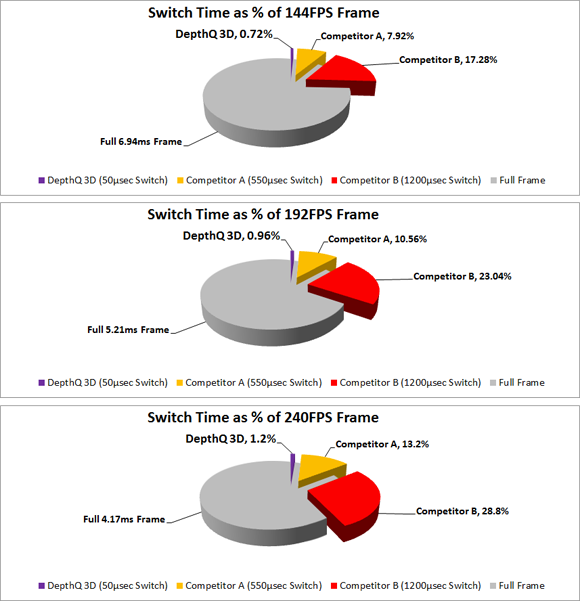
With HFR 3D, long Switch Times become increasingly impactful on brightness. Only DepthQ allows you to take advantage of the fastest projector Dark Time at all true HFR frame rates.
Q: What is Total System Efficiency?
A: Total System Efficiency is how much light your paying customers actually see (per eye), after accounting for Optical Efficiency, Dark Time, color calibration, port glass, and screen/eyewear losses. The de facto industry standard was set by RealD, at ~15%.
DepthQ Standard
A Total System Efficiency of ~16% is achievable using DepthQ Standard paired with commercially available, low-cost glasses.
DepthQ CineBright
Because it recycles some of that lost light, you can expect DepthQ CineBright to achieve ~25.5% Total System Efficiency with those same glasses.
A 3D product's required Dark Time is really the most significant factor when it comes to Total System Efficiency, as this dramatically effects how much light your patrons ultimately see. It's often conspicuously absent from marketing.
Q: Why do some products' efficiency comparisons seem skewed?
A: Competitors' marketing sometimes compares their Optical Efficiency against another company's more meaningful Total System Efficiency, creating a misleading impression. The reality is all LC based polarization switches start with nearly identical 'Optical Efficiencies' of ~17% - one factor of many to follow. DepthQ 3D has consistently stated our efficiency at a conservative ~15% for DepthQ Standard, using the only efficiency that really matters - Total System Efficiency. This follows the industry's de facto standard.
But you can hit ~16% with DepthQ Standard and ~25.5% with DepthQ CineBright using a new screen and efficient port glass (and without resorting to more expensive 'Premium Glasses').
Q: So who's really brighter in the end?
DepthQ Standard
Using our Optical Efficiency of ~17.5%, and our competitors' optical efficiencies and dark times from their manuals or marketing, DepthQ Standard (DT of 350µsec) is ~18% brighter than a competing modulator (DT of 1200µsec) and ~12% brighter than a spinning wheel system (DT of 1157µsec).
In a direct test, DepthQ Standard proved ~9% brighter than another competing modulator (DT of 350µsec, true switch time 520µsec) (Tested 3/18/2013).
DepthQ CineBright
In another fair and detailed direct brightness comparison conducted by an industry professional installer, DepthQ CineBright was shown to be ~7% brighter than the market leader's light recycling product. (Tested 1/19/2015)
Q: How does Total System Efficiency relate to lamp life?
A: Falling below the recommended end-of-life foot-lamberts for 3D cinema (6 - 4.5fL) too soon before your lamp's true end-of-life is costly. DepthQ 3D's higher Total System Efficiencies allow you to hit your foot-Lamberts spec longer, maximizing your lamp investment.
The comparisons below show the difference in useful 3D Lamp Life at standard and HFR frame rates between DepthQ Standard and a competitor's product (DT 1200µsec). Click the image to view a larger version.
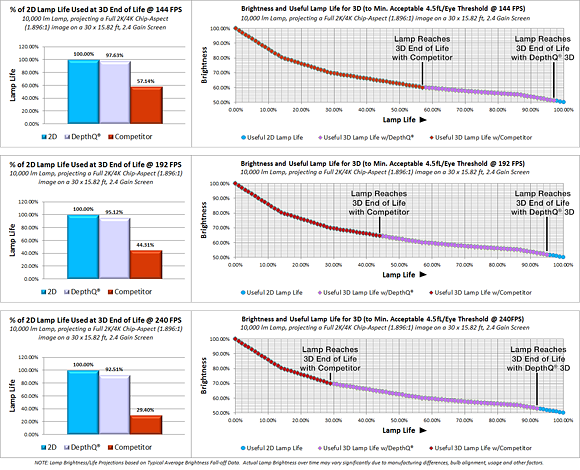
DepthQ Standard's higher Total System Efficiency allows you to hit your min. fL spec longer, maximizing your lamp investment. Click the image to view a larger version.
Q: How does 'maximizing lamp life' equate to cost savings?
A: Bottom line...DepthQ 3D saves you money on lamp costs (you can change your lamps less frequently).
DepthQ Standard
Using the same products and specifications in the comparisons above in FAQ 11, including a 10K lumen lamp running 24FPS content at 144FPS 6 hrs/day 6 days/week on a 32' screen, and a 3D end-of-life of 4.5 ft-Lamberts, DepthQ Standard will save you approximately $500 to $1200 annually (USD) per 3D screen.
DepthQ CineBright
Using DepthQ CineBright, you can also not only drop to a less-bright, less-expensive lamp to maintain the same foot-Lamberts in brightness, but use significantly less electricity. Comparing the same products and specifications as left you could save ~$800 to $1550 annually (USD) per 3D screen.
Q: What are your recommended Maximum Screen Widths?
A: Our recommended Maximum Screen Widths for each DepthQ 3D technology vary, based on the brightness of your projector and your target foot-Lamberts. Please reference the following chart:
|
30K+ Lumens
4.5 fL |
30K+ Lumens
6.0 fL |
20K Lumens
4.5 fL |
20K Lumens
6.0 fL |
15K Lumens
4.5 fL |
15K Lumens
6.0 fL |
| DepthQ Standard |
19.2 m +
(62.9 ft +) |
16.6 m +
(54.4 ft +) |
15.6 m
(51.3 ft) |
13.6 m
(44.4 ft) |
13.6 m
(44.4 ft) |
11.7 m
(38.5 ft) |
| DepthQ CineBright |
24.3 m +
(79.7 ft +) |
21 m +
(69 ft +) |
19.8 m
(65.1 ft) |
17.2 m
(56.4 ft) |
17.2 m
(56.4 ft) |
14.9 m
(48.8 ft) |
Q: How do you calculate your Maximum Screen Width estimates?
A: We believe in presenting somewhat conservative numbers in our marketing that take into account typical real-world additional losses like projector dark time, color-correction and port glass. Additionally, for any given lamp power, we target the largest screen size that still provides at least 25% lamp headroom - to allow for the inevitable brightness loss that occurs as your lamp ages.
This means using our published Maximum Screen Width estimates you would typically continue to be able to hit your 3D foot-Lamberts goal even when your lamp has lost 50% of its expected useful brightness.
Maximum screen size estimates are easily inflated by ignoring real-world losses and/or reducing lamp brightness headroom - so you could theoretically use the same lamp on a bigger screen, but you'd be changing the lamp much more frequently. Our calculations are cross-referenced using both the Christie Digital and Barco calculators.
Q: What are the DepthQ 3D Products' Throw Ratio limits?
DepthQ Standard
Model DPM-L-DCI/EL3G
>= .8 : 1 in either FLAT or SCOPE
No Minimum Throw Distance
DepthQ CineBright
Model DPM-CBV2-DCI/EL3G
SCOPE: >= 1.17 : 1
FLAT: >= 1.36 : 1
Model DPM-CBST-DCI/EL3G
SCOPE: >= 1.13 : 1
FLAT: >= 1.13 : 1
Minimum Throw Distance: 11m (36.1')
Q: What do you mean by 'Advanced Heat Protection'?
A: Only DepthQ 3D protects your investment from heat degradation over time with our advanced heat-rejecting metallic polarizer. You won't burn it up. It won't yellow. It won't degrade. All our competitors use...plastic laminated to glass. Click 'Play' to view actual comparison tests below:
2KW lamp test compares the optical properties of a competing polarization modulator and a DepthQ Standard, demonstrating each product's heat absorption properties.
4KW lamp test demonstrates how quickly an unprotected plastic-laminated-to-glass polarizing element can be destroyed by a relatively bright video projector, while DepthQ Standard's polarizer remains unscathed.
Q: What is the Maximum Projector Power DepthQ 3D allows?
A: DepthQ 3D, with its heat-rejecting metallic pre-polarizer, accepts up to 56K lumens - so protects your investment whether your light source is lamp or laser (and is compatible with all laser types.
Q: Other products have a bigger aperture. Isn't that better?
A: Not at all. Large aperture devices require their apertures to be filled with light in order to stay cool, often causing you to move your projector back. DepthQ 3D's heat-rejecting metallic polarizer allows a smaller aperture, letting you stay close to the lens to save space in your booth and minimize installation expense.
Q: Why do I see image softness and warping in other products?
A: Our competitor's products are not necessarily flat optically, and can soften or warp your image. DepthQ 3D is laser-tested to meet a precise flatness specification, keeping your images sharp and uniformly focused. Click 'Play' to see the video proof below (current small image shows warping clearly - we recommend full-screen and HD modes to plainly evaluate focus):
DepthQ 3D is laser-tested to meet a precise flatness specification, keeping your images sharp and uniformly focused.
Q: What is your Contrast Ratio?
A: When it comes to contrast specifications, the true limiting factor is the quality of the silver screens, which are generally around 50:1. All polarized 3D products are subject to this constraint. Our contrast is >100:1, which exceeds the screen.
Q: How is DepthQ 3D superior to a spinning wheel polarizer?
A: Besides the significantly longer Dark Time and lower Total System Efficiency, a mechanical spinning wheel that creates static electricity and attracts dust and popcorn oil is a high maintenance device. Additionally, there is a recurring $500 expense to replace the wheel approximately once per year. In contrast, DepthQ 3D is a solid state, low-maintenance device that simply delivers more light to your guests.
Based on the published efficiency data from marketing and manuals, a spinning wheel polarizer (DT of 1157µsec) operating at 144FPS is expected to be ~11% dimmer than DepthQ Standard (DT of 350µsec). However, in a real-world comparison in an operating theater, a recently installed spinning wheel polarizer combined with its currently shipped matching 3D eyewear actually measured ~18% dimmer than DepthQ Standard combined with its matching inexpensive 3D eyewear (Tested 3/18/2013).
In another real-world comparison in an operating theater, a spinning wheel polarizer with 628 hours of operation combined with its currently shipped matching 3D eyewear measured ~30% dimmer than DepthQ Standard combined with its matching inexpensive 3D eyewear (Tested 10/9/2012). The polarizer wheel itself was visibly yellow; the projected image dim and soft.
In contrast, DepthQ 3D protects your investment from heat degradation over time with our advanced heat-rejecting metallic polarizer. You won't burn it up. It won't yellow. It won't degrade.
Back to top
Miscellaneous Questions:
Q: Will DepthQ 3D work with my digital projector?
A: DepthQ 3D works with any DCI-compliant DLP projector.

DepthQ Standard installed with 6KW projector at a VOX theater, Dubai. Click to enlarge.

DepthQ CineBright installed with 6KW projector in Belgium. Click to enlarge.
Q: Can I easily move DepthQ 3D out of the way for 2D movies?
A: Yes. DepthQ 3D includes a moving actuator with an easily-implemented IP remote control capability to automatically move the unit out of the way for 2D content, and back in place for 3D content.
DepthQ Standard
Total travel time: ~4 seconds.
DepthQ CineBright
Total travel time: ~8 seconds
Q: Can I install DepthQ 3D directly to my wall?
A: DepthQ Standard includes all the hardware necessary to mount directly to a wall, table, or in a rack.

DepthQ Standard includes all the hardware necessary to mount directly to a wall, table, or in a rack.
We recommend the DepthQ CineBright system be rack-mounted in order to keep its relationship closely tied to the projector (and we include all the parts required). However, for 'boothless installations', CineBright can be mounted to a table (see rendering below).
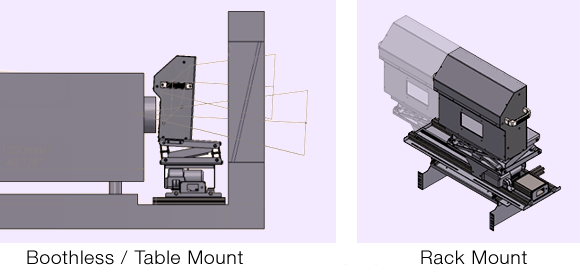
DepthQ CineBright can be mounted in a rack or directly to a table for 'boothless' installations.
Q: Are your glasses costly and heavy like Active 3D and Dolby?
A: DepthQ 3D uses circular polarized 3D glasses, which are significantly lighter, more comfortable and much less expensive than either Dolby or Active systems. Additionally, DepthQ 3D is compatible with all circular polarization eyewear brands, so you can make your own choice.
Q: How does DepthQ 3D's price compare to other brands?
A: DepthQ 3D products offer substantial benefits and operational cost savings over other brands, yet remain competitively priced, and are backed by a 3D Cinema five year optical warranty and three year electronics warranty.
Q: What Is DepthQ 3D's business model?
A: Buy DepthQ 3D, and you own it forever. We require no collection of royalty, licensing fees, or participation in the box office. Plus, since our product is compatible with all circular polarization eyewear brands, you have the flexibility to use our glasses or choose your own.
Q: What do YOU mean by 'Hollywood Approved'?
A: We have demonstrated to, and been approved by six major Hollywood studios. Others' claims of 'Hollywood Approved' may just represent a single studio. Missing a studio's approval can literally lock you out of content. That's quite a risk.
Q: Why do your patents matter?
A: DepthQ 3D technology is covered by international patents - in the United States, European Union, Canada, China and Korea. These novel patents protect you from claims of IP infringement. If you buy a RealD® imitation you're taking an unnecessary risk.
DepthQ Standard & DepthQ CineBright
LC-Tec Displays AB U.S. Patent Nos. 8023052 B1 and 8184215 B2; CN102725682 B, KR20130097158 A, EP2606398 A4
DepthQ CineBright
Lightspeed Design, Inc. U.S. Patent Nos. 9494805 B2 and 9693044 B2, EP 2959341 B1, CA 2907565 C, CN 104272182 B
Q: What companies are behind DepthQ 3D?
A: With DepthQ 3D your trust is well-placed. DepthQ 3D is co-developed by Lightspeed Design, Inc. and LC-Tec Displays AB, two companies with over 50 years combined expertise in stereoscopic design and liquid crystal manufacturing and development. Lightspeed Design, Inc. is an established 3D provider for many discerning clients including Disney, Christie Digital, DreamWorks, IMAX, Mercedes, Microsoft, Boeing, & NASA. LC-Tec invented rugged, fast polarization technology so innovative the original company and patents were purchased by 3M.
When you take in every technical and business factor - superior optics, brightness, speed, sharpness, heat protection, true HFR, six studio approvals, IP protection, simple business model, lamp savings, 3D Cinema five year optical warranty and client satisfaction - DepthQ 3D is truly your "best in class" smart investment.
Back to top
Lightspeed Design is the exclusive worldwide distributor of the DepthQ 3D Polarization Products.
To purchase or for more information please use our Contact Form, or call +1.206.784.1385
About Lightspeed Design, Inc.
Lightspeed is one of the world's premiere designers of stereoscopic 3D presentations and software technologies, with considerable technical expertise in projection, optics and electronics. Lightspeed has proven expertise in 3D projection, systems design & installation, and software development. Clients include Pfizer, Intuitive Surgical, Microsoft, Harvard & Munich Universities, US Army, NASA, JPL, DreamWorks SKG and Walt Disney Animation.
DepthQ products are exclusively distributed by Lightspeed Design, Inc.
Lightspeed reserves the right to alter product offerings and specifications at any time without notice.
DepthQ is a trademark of Lightspeed Design, Inc. All other trademarks are for identification purposes only and are the property of their respective companies. All rights reserved.
|


